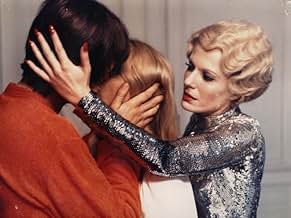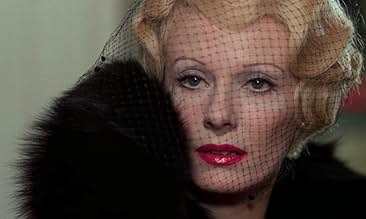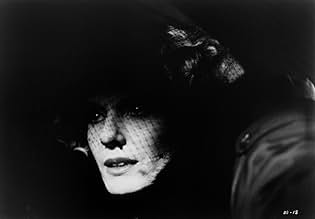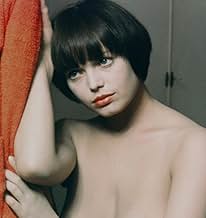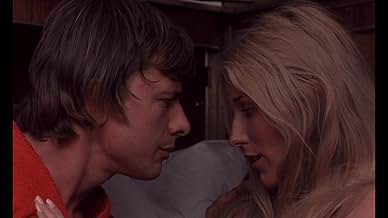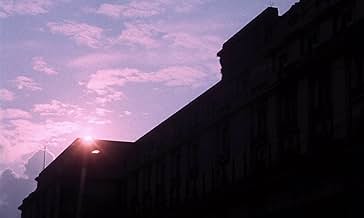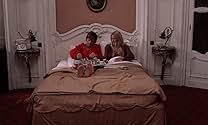NOTE IMDb
6,5/10
7,6 k
MA NOTE
Un couple de jeunes mariés traverse une station balnéaire. Leurs chemins se croisent avec une comtesse mystérieuse et d'une beauté saisissante et son assistante.Un couple de jeunes mariés traverse une station balnéaire. Leurs chemins se croisent avec une comtesse mystérieuse et d'une beauté saisissante et son assistante.Un couple de jeunes mariés traverse une station balnéaire. Leurs chemins se croisent avec une comtesse mystérieuse et d'une beauté saisissante et son assistante.
- Réalisation
- Scénario
- Casting principal
Avis à la une
While I appreciate vampires as a staple of the horror genre, I have never been a big fan of vampire films. And while I will be the first to laud the merits of Bela Lugosi and Christopher Lee's contributions to the cape, they look rather timid next to Countess Elizabeth Bathory (the luminous and sensual Delphine Seyrig) in "Daughters of Darkness." While Harry Kumel's film is one of the most aesthetically beautiful vampire pictures ever lensed, dripping with subtle sexual tension, it also presses forth with a feminist/lesbian subtext that's as alluring as it is clever. The plot is relatively straightforward, and the film takes its time in establishing mood and atmosphere--Valerie (Danielle Ouiment) and Stefan (John Karlen) are newlyweds who are on the rocks only 3 hours into the marriage, and things are complicated further when Countess Bathory and her assistant, Ilona (Andrea Rau) check into the same deserted seaside hotel. While the atmosphere could be compared to the Universal and Hammer horrors, Kumel's artistry--with well-framed images, emphasis on wardrobe, and a very deliberate color scheme--exists in its own unique league. The topic of lesbianism--and even heterosexuality--is presented in a minimalist, unexploitative manner, yet maintains a pervasive eroticism throughout. Even the vampiric seduction is presented with a minimum of graphic bloodshed, which is all the more effective. "Daughters of Darkness" is the type of moody, character-driven piece that plays like a sensual sister to George Romero's similarly unique "Martin." As my comment title implies, this is an excellent film, required viewing for fans of horror and great art alike.
Beware as you go into this, it may sound like Hammer but it's nothing like it. It's a chic, stylish vampire film dripping with the most wanton aestheticism. The whole thing exudes the scent of an absinthe dream, the contours of a flowing red dress.
Superficially it is about a couple of newly-weds - but who, as the film opens with them having sex in a train cabin, openly declare that they don't love each other - who find themselves stranded in Ostande and move in to a strangely empty hotel for a few days. A countess Bathory arrives there with her female companion, there's also the baffled concierge who tries to stay out of passion's way.
I say superficially because the dynamics between the couple is what at first sight seems to be driving the story. The woman is desperate to break out from the limbo of anonymous sex and be introduced, thus be legitimized as a wife and woman, to the man's mother, an aristocrat back in England. The man, on the other hand, is content to derail those expectations and savour the erotic dream he has concocted to inhabit.
But of course we come to understand that the narrative is powered from outside. The countess courts both, seducing in the emotional space between them. She personifies that wanton aestheticism right down to her body language. It is important to note that she is played by the actress who starred in Marienbad for Resnais, which this film alludes to; in the mysterious hotel setting with its expansive balustrades, in the twilight wanderings, in the sense of time revoked and sensations amplified.
She is the architect of all this, building around these people the desires that will yield them to her. So it is the man's semi-conscious world of secret pleasures, but it's she who is slowly, slyly perverting them. She does this with the malevolent purity of a femme fatale.
It does not matter that she is Bathory, or that blood is eventually savored from wrists, this is merely the desire made visible in a way that would appeal to a niche audience. So even though Jess Franco borrowed the velvety sunsets and decadent air from this for Vampyros Lesbos, this operates deeper. It matters for example that she seduces the man into a new obsession with violence, the destructive flipside of eros. It further pries the woman apart from him.
Gradually what was a matter of taking pleasure from flesh is spun into something else entirely; again involving flesh but now literally draining from his.
It ends with a stunning sequence across countryside roads; a lot of the imagery recalls L'Herbier - who also inspired Resnais - but here more pertinently. The soul has been so withered away from inside, so consumed from the fever of passion, that mere sunlight sends it reeling. Of course we can explain away by falling back to our knowledge of vampire lore, but we'd be missing on the finer abstractions; how, for example, the femme fatale is magically cast into the circumstances that, as we know from our knowledge of this type of film, would precipitate her demise. Nothing else would do after all.
If we follow the set of reactions from what at first sight appears like an accident, it can be plainly seen how it all flows from her desire to control the narrative.
It's marvelous stuff just the same, the colors, the desolate aura. I just want to urge you to see as more than just an 'artsy vampire flick'. Save that for Jean Rollin.
Superficially it is about a couple of newly-weds - but who, as the film opens with them having sex in a train cabin, openly declare that they don't love each other - who find themselves stranded in Ostande and move in to a strangely empty hotel for a few days. A countess Bathory arrives there with her female companion, there's also the baffled concierge who tries to stay out of passion's way.
I say superficially because the dynamics between the couple is what at first sight seems to be driving the story. The woman is desperate to break out from the limbo of anonymous sex and be introduced, thus be legitimized as a wife and woman, to the man's mother, an aristocrat back in England. The man, on the other hand, is content to derail those expectations and savour the erotic dream he has concocted to inhabit.
But of course we come to understand that the narrative is powered from outside. The countess courts both, seducing in the emotional space between them. She personifies that wanton aestheticism right down to her body language. It is important to note that she is played by the actress who starred in Marienbad for Resnais, which this film alludes to; in the mysterious hotel setting with its expansive balustrades, in the twilight wanderings, in the sense of time revoked and sensations amplified.
She is the architect of all this, building around these people the desires that will yield them to her. So it is the man's semi-conscious world of secret pleasures, but it's she who is slowly, slyly perverting them. She does this with the malevolent purity of a femme fatale.
It does not matter that she is Bathory, or that blood is eventually savored from wrists, this is merely the desire made visible in a way that would appeal to a niche audience. So even though Jess Franco borrowed the velvety sunsets and decadent air from this for Vampyros Lesbos, this operates deeper. It matters for example that she seduces the man into a new obsession with violence, the destructive flipside of eros. It further pries the woman apart from him.
Gradually what was a matter of taking pleasure from flesh is spun into something else entirely; again involving flesh but now literally draining from his.
It ends with a stunning sequence across countryside roads; a lot of the imagery recalls L'Herbier - who also inspired Resnais - but here more pertinently. The soul has been so withered away from inside, so consumed from the fever of passion, that mere sunlight sends it reeling. Of course we can explain away by falling back to our knowledge of vampire lore, but we'd be missing on the finer abstractions; how, for example, the femme fatale is magically cast into the circumstances that, as we know from our knowledge of this type of film, would precipitate her demise. Nothing else would do after all.
If we follow the set of reactions from what at first sight appears like an accident, it can be plainly seen how it all flows from her desire to control the narrative.
It's marvelous stuff just the same, the colors, the desolate aura. I just want to urge you to see as more than just an 'artsy vampire flick'. Save that for Jean Rollin.
This viewer will admit right off that he is more accustomed to horror movies of the more traditional kind. However, that doesn't mean that he can't appreciate what a movie like this tries to do. Harry Kumel's "Les Levres Rouges", a.k.a. "Daughters of Darkness", as I am sure has been said numerous times before, has higher aspirations than cheap thrills. (That doesn't mean, however, that fans hoping for a trash quotient won't get it, as there is a fairly generous dose of nudity, male and female, in one key scene.) It's stately, intelligent, and very deliberately paced, with a clear focus on character and ambiance. Now, there are some genuine shock moments and scenes of sudden violence, but they are few and far between.
The action, so to speak, is mostly set inside a vast, opulent hotel that a honeymooning couple is visiting in the wintertime. So, it is actually almost empty, until the couple, Stefan (John Karlen) and Valerie (Danielle Ouimet) make the acquaintance of sophisticated Countess Bathory (Delphine Seyrig), who just might be THE Elizabeth Bathory of real-life infamy, and her sultry companion, Ilona (Andrea Rau).
Enhanced by lovely music composed by Francois de Roubaix, the movie, just like its cagey main character, has a certain, seductive allure going for it; it's hard not to be captivated by Seyrigs' performance and hang on to every word she speaks. One can sense that her presence can only lead this young couple to some pretty dark places, as passionate impulse takes over and the violent side of Stefans' personality is more prone to emerge. In fact, as this story plays out, The Countess doesn't seem as bad as Stefan turns out to be.
The other actors do a fine job of reinforcing the notion that a substantial part of acting is REACTING, as their characters feel the influence of this sexy stranger. The atmosphere and mood of this movie are simply excellent, as right from the get go, there is a very somber feel to the characters and dialogue. Stefan and Valerie go so far as to admit that their relationship is not really based on love. Character details like this are given throughout; Stefan reacts with more than casual curiosity to being present at a murder scene, and when he and the Countess recount the horrific acts of Elizabeth Bathory, it arouses them more and more; Valerie yells at them to stop, and is it the sordid nature of what they speak, the fact that they're getting turned on, or both, that is unnerving Valerie? What the characters realize about themselves and the others becomes vitally important to what unfolds.
With its elements of lesbianism, eroticism, and sadomasochism, this is an interesting piece of cinema for patient viewers.
Seven out of 10.
The action, so to speak, is mostly set inside a vast, opulent hotel that a honeymooning couple is visiting in the wintertime. So, it is actually almost empty, until the couple, Stefan (John Karlen) and Valerie (Danielle Ouimet) make the acquaintance of sophisticated Countess Bathory (Delphine Seyrig), who just might be THE Elizabeth Bathory of real-life infamy, and her sultry companion, Ilona (Andrea Rau).
Enhanced by lovely music composed by Francois de Roubaix, the movie, just like its cagey main character, has a certain, seductive allure going for it; it's hard not to be captivated by Seyrigs' performance and hang on to every word she speaks. One can sense that her presence can only lead this young couple to some pretty dark places, as passionate impulse takes over and the violent side of Stefans' personality is more prone to emerge. In fact, as this story plays out, The Countess doesn't seem as bad as Stefan turns out to be.
The other actors do a fine job of reinforcing the notion that a substantial part of acting is REACTING, as their characters feel the influence of this sexy stranger. The atmosphere and mood of this movie are simply excellent, as right from the get go, there is a very somber feel to the characters and dialogue. Stefan and Valerie go so far as to admit that their relationship is not really based on love. Character details like this are given throughout; Stefan reacts with more than casual curiosity to being present at a murder scene, and when he and the Countess recount the horrific acts of Elizabeth Bathory, it arouses them more and more; Valerie yells at them to stop, and is it the sordid nature of what they speak, the fact that they're getting turned on, or both, that is unnerving Valerie? What the characters realize about themselves and the others becomes vitally important to what unfolds.
With its elements of lesbianism, eroticism, and sadomasochism, this is an interesting piece of cinema for patient viewers.
Seven out of 10.
I first saw this movie when I was 12 and it had a huge impact on my early artistic endeavors as a young man. I've seen it periodically over the years and can see what intrigued me about it so much. It's part Ingmar Bergman film and part bad vampire movie. There are some beautifully filmed scenes along with some awful dialogue. The brilliant Delphine Seyrig is superbly creepy. The other performances are only mediocre. The music is appropriately over the top; sometimes sinister, sometimes goofy- seventies movie. The new director's cut contains more sex and nudity, probably to avoid getting an x-rating at the time of release. It's definitely worth checking out if you've never seen it.
The follow-up to Kümel's "Malpertuis" (from Jean Ray's book),"Les Lèvres Rouges " has got a much simpler screenplay and ,with one exception no great stars (no Orson Welles,Michel Bouquet,Susan Hampshire ,Jean-Pierre Cassel.....)....
One star ,but what a star!Delphine Seyrig was one of the greatest stars France had ever had.She mesmerized her audience as no actress of her generation could;her death was a major loss for the European cinema.She could play the fairy godmother of "Peau D'Ane ",the dumb bourgeois lady of "Le Charme Discret De La Bourgeoisie" or the legendary bloody countess -many historians do not believe in those blood baths -with the same aplomb;three parts so different and the same woman with the same suave voice -you MUST hear her speak,a dubbed version would be a disaster;so make sure you get a DVD with subtitles.
I have always thought Belgian directors were very good at creating a supernatural atmosphere without using a ton of special effects;like Delvaux in "Un Soir Un Train" ,Kümel makes the simple picture of a train which comes to a standstill.The baroque hotel will remind some users of "L'Année Dernière A Marienbad" ,Seyrig's debut in France.
It's to state the obvious to write that Seyrig steals every scene she is in and fortunately she's featured in many scenes ;the three other leads seem bland by comparison and it takes all the talent of the director to pull them off.
"Les Levres Rouges" gave a renewed life to the vampire movie ,like Polanski's "the fearless vampire killers" did in the precedent decade .A strong lesbian interest in this movie too:Seyrig was so hot she could appeal to both men and women.
One star ,but what a star!Delphine Seyrig was one of the greatest stars France had ever had.She mesmerized her audience as no actress of her generation could;her death was a major loss for the European cinema.She could play the fairy godmother of "Peau D'Ane ",the dumb bourgeois lady of "Le Charme Discret De La Bourgeoisie" or the legendary bloody countess -many historians do not believe in those blood baths -with the same aplomb;three parts so different and the same woman with the same suave voice -you MUST hear her speak,a dubbed version would be a disaster;so make sure you get a DVD with subtitles.
I have always thought Belgian directors were very good at creating a supernatural atmosphere without using a ton of special effects;like Delvaux in "Un Soir Un Train" ,Kümel makes the simple picture of a train which comes to a standstill.The baroque hotel will remind some users of "L'Année Dernière A Marienbad" ,Seyrig's debut in France.
It's to state the obvious to write that Seyrig steals every scene she is in and fortunately she's featured in many scenes ;the three other leads seem bland by comparison and it takes all the talent of the director to pull them off.
"Les Levres Rouges" gave a renewed life to the vampire movie ,like Polanski's "the fearless vampire killers" did in the precedent decade .A strong lesbian interest in this movie too:Seyrig was so hot she could appeal to both men and women.
Le saviez-vous
- AnecdotesDuring filming, director Harry Kümel hit actress Danielle Ouimet during a dispute. Actor John Karlen was so infuriated by this behavior that he punched Kumel in the face. The atmosphere on the set was understandably tense afterwards.
- GaffesWhen Ilona is lying on the bathroom floor, bikini marks are visible. Vampires are not supposed to have tan lines.
- Citations
Countess Bathory: Love is stronger than death... even than life.
- Versions alternativesThe original U.S. theatrical release was cut by approximately 12 minutes to obtain an R-rating, and features a slightly different opening credits sequence in which Lainie Cooke (not Delphine Seyrig as sometimes rumored) sings over the main theme of the film. This sequence features a stylized title logo (the same as that on the U.S. posters), while the rest of the credits use a font that is more formal and less bold compared to the original version. After being released on Canadian and American VHS (where it was retitled "Children of the Night"), the U.S. version was eventually replaced in circulation by the uncut version in the 1990s, although its title sequence is presented among the special features of Blue Underground's 2020 4K Blu-ray release of the film.
- ConnexionsEdited into Rob Zombie: Living Dead Girl (1999)
- Bandes originalesDaughters of Darkness
Written and Performed by François de Roubaix
Sung by Lainie Cooke
Lyrics by Terence Stockdale
Meilleurs choix
Connectez-vous pour évaluer et suivre la liste de favoris afin de recevoir des recommandations personnalisées
- How long is Daughters of Darkness?Alimenté par Alexa
Détails
- Date de sortie
- Pays d’origine
- Langues
- Aussi connu sous le nom de
- Daughters of Darkness
- Lieux de tournage
- Sociétés de production
- Voir plus de crédits d'entreprise sur IMDbPro
Box-office
- Budget
- 750 000 $US (estimé)
- Montant brut mondial
- 1 070 $US
- Durée1 heure 27 minutes
- Couleur
- Mixage
- Rapport de forme
- 1.66 : 1
Contribuer à cette page
Suggérer une modification ou ajouter du contenu manquant

Lacune principale
By what name was Les lèvres rouges (1971) officially released in India in English?
Répondre

